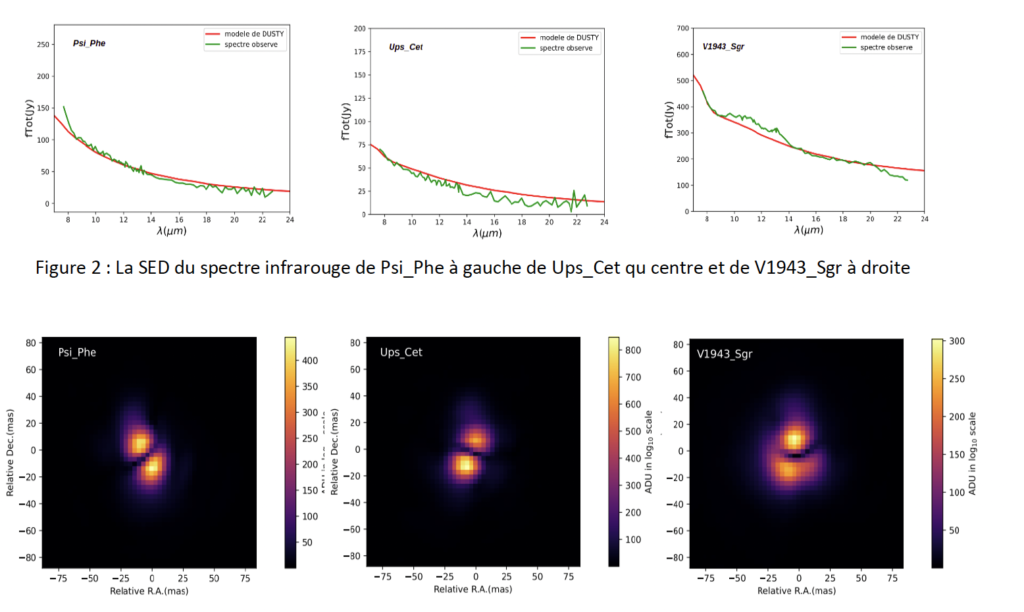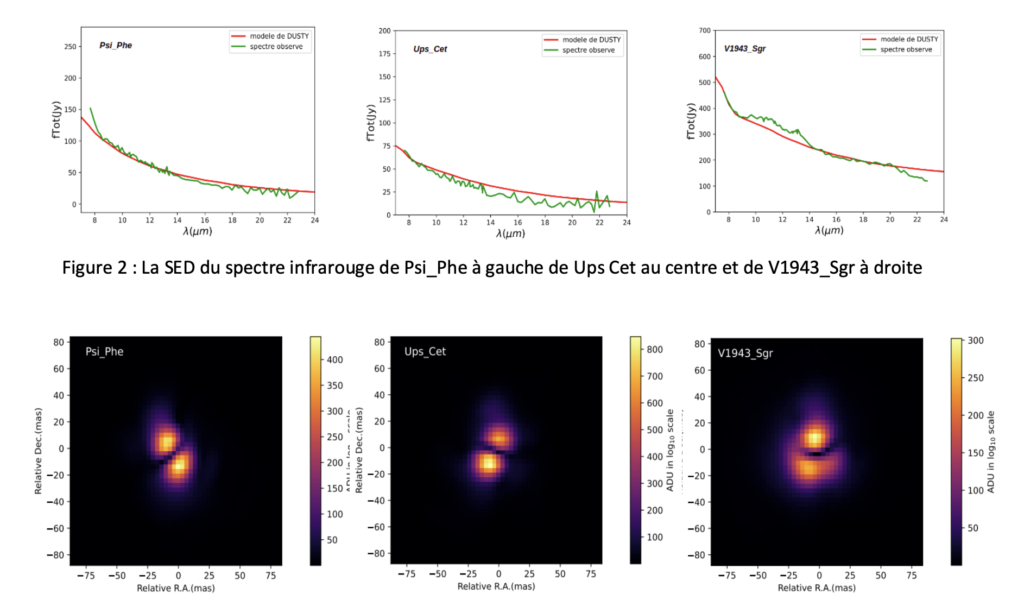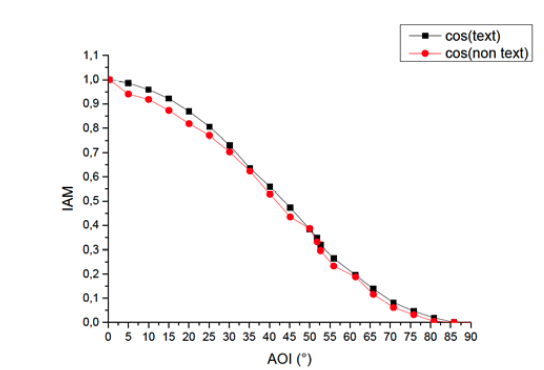Perte de masse des étoiles évoluées via des observations avec SPHERE au VLT
- Post by: SOAPHYS-KZ
- 23 novembre 2023
- Comments off


http://dx.doi.org/10.46411/jpsoaphys.2023.013
Section de la parution: Informations de publication
J. P. Soaphys, Vol 3, N°2 (2023) C23N12
Pages : C23N12-1 à C22N12-6
Informations sur les auteurs
Perte de masse des étoiles évoluées via des
observations avec SPHERE au VLT
N. Aymard.
Badolo1,2, S. Zacharie Kam1, Eric Lagadec2,
Vincent Hocde2, Fabrice Bado1,2, Jean Koulidiati1
1Observatoire d’astrophysique, Laboratoire de
Physique et de Chimie de l’Environnement (LPCE), Université Joseph Ki-Zerbo
(UJKZ), Burkina Faso,
2Laboratoire Lagrange, Parc Valrose, UMR7293,
Observatoire de la Côte d’Azur, 06108, Nice, France
Corresponding author e-mail: aymard.badolo@ujkz.bf
ABSTRACT
Les étoiles branche asymptotique des géantes (AGB) perdent une énorme quantité de matière d’une manière peu comprise à ce jour. Nous avons voulu mieux comprendre les mécanismes auteurs de la diminution considérable de la masse des étoiles pouvant avoisiner les trois quarts de la masse initiale de l’étoile. Nous avons étudié les spectres IRAS (InfraRed Astronomical Satellite) de trois étoiles AGB, V1943_Sgr, Psi_Phe et Ups_Cet, que nous avons modélisés grâce au code de transfert radiatif DUSTY afin de déterminer leurs propriétés. Les données polarimétriques de ces étoiles obtenues grâce à la caméra ZIMPOL nous ont permis de construire des cartes de flux polarisé pour ces étoiles. Grâce aux cartes de flux polarisé, nous avons prouvé l’existence d’enveloppe de poussière autour des trois étoiles. Nos travaux ont cofirmé que V1943_Sgr, Psi_Phe et Ups_Cet sont des étoiles AGB.
Keywords : Evolved stars ; mass-loss ; SPHERE; DUSTY ; polarisation
RESUME
The Asymptotic Giant Branch (AGB) stars lose a huge amount of matter and the mechanism of this massloss is not yet well understood. We wanted to better understand this mechanism using data from SPHERE. IRAS spectra of three AGB stars V1943_Sgr, Psi_Phe et Ups_Cet have been used to determine their properties. The polarimetric data of each star from ZIMPOL allowed us to make they polar maps. Thanks to theses colormaps, we were able to prove the existence of dust envelop around each star confirming that they are AGB stars.
Mots-Clés : Étoiles évoluées ; perte de masse; SPHERE ; DUSTY ; polarisation
| [1] A. Maëder, « Stellar yields as a function of initial metallicity and mass limit for black hole formation », Astronomy and Astrophysics (ISSN 0004-6361), vol. 264, no. 1, p. 105-120., 1992. | ||||
| [2] J.-L. Beuzit et al., « SPHERE: the exoplanet imager for the Very Large Telescope », Astron. Astrophys., vol. 631, p. A155, nov. 2019, doi: 10.1051/0004-6361/201935251. https://doi.org/10.1051/0004-6361/201935251 |
||||
| [3] C. Yeşilyaprak et Z. Aslan, « Period-luminosity relation for M-type semiregular variables from Hipparcos parallaxes », Mon. Not. R. Astron. Soc., vol. 355, no 2, p. 601 607, déc. 2004, doi: 10.1111/j.1365-2966.2004.08344.x. https://doi.org/10.1111/j.1365-2966.2004.08344.x |
||||
| [4] P. C. Keenan et R. C. McNeil, « The Perkins catalog of revised MK types for the cooler stars », Astrophys. J. Suppl. Ser., vol. 71, p. 245, oct. 1989, doi: 10.1086/191373. https://doi.org/10.1086/191373 |
||||
| [5] H. C. Woodruff et al., « Interferometric observations of the Mira star o Ceti with the VLTI/VINCI instrument in the near-infrared », USA, oct. 2004, p. 1707. doi: 10.1117/12.551245. https://doi.org/10.1117/12.551245 |
||||
| [6] H. R. Neilson et J. B. Lester, « Determining parameters of cool giant stars by modeling spectrophotometric and interferometric observations using the SAtlas program », Astron. Astrophys., vol. 490, no 2, p. 807 810, nov. 2008, doi: 10.1051/0004-6361:200810627. https://doi.org/10.1051/0004-6361:200810627 |
||||
| [7] W. Hagen, « Circumstellar gas and dust shells of M giants and supergiants », Astrophys. J. Suppl. Ser., vol. 38, p. 1, sept. 1978, doi: 10.1086/190542. https://doi.org/10.1086/190542 |
||||
| [8] C. B. Stephenson, « A study of visual binaries having primaries above the main sequence. », Astron. J., vol. 65, p. 60, mars 1960, doi: 10.1086/108191. https://doi.org/10.1086/108191 |
||||
| [9] I. McDonald, A. A. Zijlstra, et R. A. Watson, « Fundamental parameters and infrared excesses of Tycho-Gaia stars », Mon. Not. R. Astron. Soc., vol. 471, no 1, p. 770 791, oct. 2017, doi: 10.1093/mnras/stx1433. https://doi.org/10.1093/mnras/stx1433 |
||||
| [10] H. Olofsson, D. González Delgado, F. Kerschbaum, et F. L. Schöier, « Mass loss rates of a sample of irregular and semiregular M-type AGB-variables », Astron. Astrophys., vol. 391, no 3, p. 1053 1067, sept. 2002, doi: 10.1051/0004-6361:20020841. https://doi.org/10.1051/0004-6361:20020841 |
||||
| [11] A. M. Heras et S. Hony, « Oxygen-rich AGB stars with optically thin dustenvelopes », Astron. Astrophys., vol. 439, no 1, p. 171 182, août 2005, doi: 10.1051/0004-6361:20042296. https://doi.org/10.1051/0004-6361:20042296 |
||||
| [12] T. Danilovich et al., « New observations and models of circumstellar CO line emission of AGB stars in the Herschel SUCCESS programme », Astron. Astrophys., vol. 581, p. A60, sept. 2015, doi: 10.1051/0004-6361/201526705. https://doi.org/10.1051/0004-6361/201526705 |
||||
| [13] A.-L. Maire et al., « VLT/SPHERE astrometric confirmation and orbital analysis of the brown dwarf companion HR 2562 B », Astron. Astrophys., vol. 615, p. A177, juill. 2018, doi: 10.1051/0004-6361/201732476. https://doi.org/10.1051/0004-6361/201732476 |
||||
| [14] P. Delorme et al., « The SPHERE data center: a reference for high contrast imaging processing », ArXiv171206948 Astro-Ph, déc. 2017, Consulté le: déc. 03, 2021. [En ligne]. Disponible sur: http://arxiv.org/abs/1712.06948 | ||||
| [15] Z. Ivezic, M. Nenkova, et M. Elitzur, « User Manual for DUSTY », ArXivastro-Ph9910475, oct. 1999, Consulté le: déc. 09, 2021. [En ligne]. Disponible sur: http://arxiv.org/abs/astro-ph/9910475 | ||||
| [16] C. W. Engelke, « Analytic approximations to the 2-60 microns infrared continua for standard calibration stars – With application to the calibration of spectroscopy and photometry, and the determination of effective temperature and angular size from IR measurements », Astron. J., vol. 104, p. 1248, sept. 1992, doi: 10.1086/116314. https://doi.org/10.1086/116314 |
||||
| [17] M. Marengo, M. Busso, G. Silvestro, P. Persi, et P. O. Lagage, « Mid-infrared colors as a diagnostic tool of circumstellar envelopes in AGB stars? », Astron. Astrophys. 348, 501-511 (1999), 1999. | ||||
| [18] M. Nicolle, « Ground layer correction for very large telescopes: performance of multi-object wave-front sensing concepts. », SF2A-2005: Semaine de l’Astrophysique Francaise, meeting held in Strasbourg, France, June 27 – July 1, 2005, Edited by F. Casoli, T. Contini, J.M. Hameury and L. Pagani. Published by EdP-Sciences, Conference Series, 2005, p. 235, 2005. | ||||
| [19] H. M. Schmid et al., « SPHERE / ZIMPOL high resolution polarimetric imager. I. System overview, PSF parameters, coronagraphy, and polarimetry », Astron. Astrophys., vol. 619, p. A9, nov. 2018, doi: 10.1051/0004-6361/201833620. https://doi.org/10.1051/0004-6361/201833620 |
||||
| [20] P. Kervella, M. Montargès, et E. Lagadec, « The nearby AGB star L2 Puppis: the birth of a planetary nebula ? », EAS Publ. Ser., vol. 71 72, p. 211 216, 2015, doi: 10.1051/eas/1571048. https://doi.org/10.1051/eas/1571048 |
||||
| [21] A. Bazzon, « Polarimetry of Planets in the solar system and beyond », ETH Zurich, 2013. doi: 10.3929/ETHZ-A-010087118. | ||||


